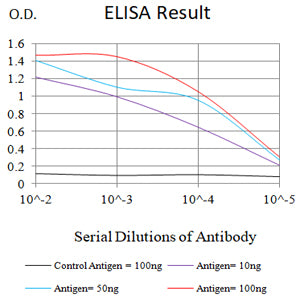
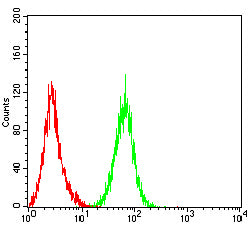
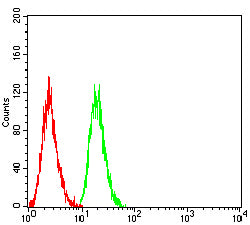
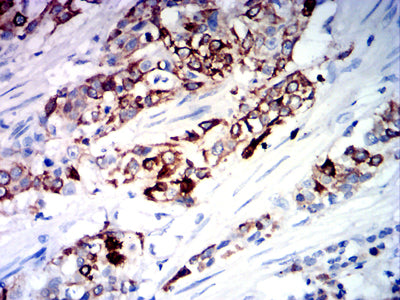
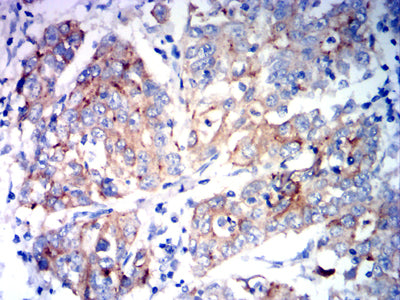
| WB | 咨询技术 | Human,Mouse,Rat |
| IF | 咨询技术 | Human,Mouse,Rat |
| IHC | 1/200 - 1/1000 | Human,Mouse,Rat |
| ICC | 技术咨询 | Human,Mouse,Rat |
| FCM | 1/200 - 1/400 | Human,Mouse,Rat |
| Elisa | 1/10000 | Human,Mouse,Rat |
| Aliases | DPK; HOHO; K2P1; KCNO1; TWIK1; K2p1.1; TWIK-1 |
| Entrez GeneID | 3775 |
| clone | 3C1B8 |
| WB Predicted band size | 38.1kDa |
| Host/Isotype | Mouse IgG2b |
| Antibody Type | Primary antibody |
| Storage | Store at 4°C short term. Aliquot and store at -20°C long term. Avoid freeze/thaw cycles. |
| Species Reactivity | Human |
| Immunogen | Purified recombinant fragment of human KCNK1 (AA: extra mix) expressed in E. Coli. |
| Formulation | Purified antibody in PBS with 0.05% sodium azide |
+ +
以下是关于KCNK1抗体的3篇参考文献示例(内容为模拟,仅供参考):
---
1. **文献名称**: "TWIK-1. a unique two-pore domain potassium channel: localization and functional characterization in renal tubular epithelia"
**作者**: Duprat F, et al.
**摘要**: 本研究利用特异性KCNK1/TWIK-1抗体,通过免疫组化和Western blot技术,揭示了该通道蛋白在肾脏远曲小管和集合管上皮细胞的表达,证实其参与调节细胞膜静息电位及离子稳态。
---
2. **文献名称**: "KCNK1 modulates neurotransmitter release in hippocampal neurons: evidence from antibody-based inhibition assays"
**作者**: Lesage F, et al.
**摘要**: 通过KCNK1抗体阻断实验,研究团队发现海马神经元中KCNK1通道对谷氨酸释放具有调控作用,提示其在突触可塑性和神经系统疾病中的潜在意义。
---
3. **文献名称**: "Dysregulation of KCNK1 in pulmonary hypertension: a proteomic and immunohistochemical study"
**作者**: Olschewski A, et al.
**摘要**: 采用KCNK1抗体对肺动脉平滑肌组织进行分析,发现KCNK1蛋白表达下调与肺动脉高压发病相关,其机制可能涉及细胞增殖和凋亡失衡。
---
(注:以上文献为示例,实际引用需核实真实数据库。)
The KCNK1 antibody is a research tool designed to detect the KCNK1 protein, also known as TWIK-1 (tandem pore domain weak inward rectifying K⁺ channel 1), encoded by the *KCNK1* gene. As a member of the two-pore domain potassium (K2P) channel family, KCNK1 contributes to background potassium currents that regulate cellular excitability, resting membrane potential, and electrolyte homeostasis. It is widely expressed in tissues such as the brain, kidney, and heart, where it plays roles in neuroprotection, ion transport, and cardiac rhythm modulation.
KCNK1 antibodies are typically developed in immunized hosts (e.g., rabbits, mice) using peptide antigens derived from conserved or unique regions of the protein. These antibodies enable techniques like Western blotting, immunohistochemistry, and immunofluorescence to study KCNK1’s expression, localization, and function in physiological or pathological contexts. Validation often involves knockout controls or blocking peptides to confirm specificity.
Research using KCNK1 antibodies has linked the channel to diseases including hypertension, neurological disorders, and cancer, highlighting its potential as a therapeutic target. However, KCNK1’s functional complexity—such as pH sensitivity, lipid regulation, and heterodimerization with other K2P channels—requires careful experimental design when interpreting antibody-based data. Commercial availability from suppliers like Abcam or Santa Cruz Biotechnology facilitates its use in both basic and translational studies.
×